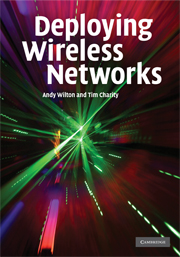Book contents
- Frontmatter
- Contents
- Foreword by Sir David Brown, FREng
- Preface
- Acknowledgements
- Authors' disclaimer
- 1 Introduction
- 2 Wireless network systems
- 3 Principles of access network planning
- 4 Introduction to RAN planning and design
- 5 GSM RAN planning and design
- 6 UMTS RAN planning and design
- 7 Cellular OFDM RAN planning and design
- 8 Mesh network planning and design
- 9 Core network and transmission
- 10 Network operation and optimisation
- Acronyms
- Index
- References
5 - GSM RAN planning and design
Published online by Cambridge University Press: 13 August 2009
- Frontmatter
- Contents
- Foreword by Sir David Brown, FREng
- Preface
- Acknowledgements
- Authors' disclaimer
- 1 Introduction
- 2 Wireless network systems
- 3 Principles of access network planning
- 4 Introduction to RAN planning and design
- 5 GSM RAN planning and design
- 6 UMTS RAN planning and design
- 7 Cellular OFDM RAN planning and design
- 8 Mesh network planning and design
- 9 Core network and transmission
- 10 Network operation and optimisation
- Acronyms
- Index
- References
Summary
System coverage and capacity
The development of a framework to assess system capacity for any air interface typically falls into two parts: firstly estimation of the S/N or C/I necessary to deliver the required bit error rate (BER) for the system in a point-to-point link and secondly understanding the limiting system conditions under which the most challenging S/N or C/I will be encountered. Once these two conditions are understood, calculations of maximum ranges and capacities for the system can be made.
C/I assessment for GSM
The base modulation scheme employed by GSM is Gaussian minimum shift keying (GMSK). This is a form of binary frequency shift keying with the input bit stream used to drive the frequency modulator filtered by a network with a Gaussian impulse response. This filter removes the high frequencies, which would otherwise be present because of the ‘fast’ edges in the modulating bit stream. If BT, the product of the filter – 3 dB bandwidth and the modulating bit period is chosen to be around 0.3, it enables most of the energy from the 270 kbits/s bit rate of GSM to be accommodated in a 200 kHz channel with low interference from the adjacent channels and negligible interference from those beyond.
Figure 5.1 illustrates the effect of the Gaussian filtering on the original rectangular pulse train and goes on to show the way inter-symbol interference arises, as multi-path introduces longer delays than that due to propagation of the direct ‘ray’.
Information
- Type
- Chapter
- Information
- Deploying Wireless Networks , pp. 100 - 146Publisher: Cambridge University PressPrint publication year: 2008
